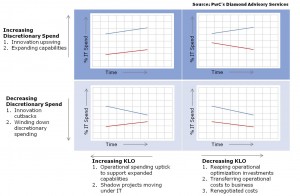How Does IT Impact Business Productivity?
post by Chris Curran on February 14, 2011Guest post by Nalneesh Gaur
Nick Carr’s controversial article on “IT doesn’t matter” published in 2003 noted that infrastructure technology is easily copied thus providing no competitive advantage. Yet, savvy businesses continue to pursue technology innovations to gain competitive advantages or improve business productivity in order to provide greater shareholder value, growth, and stability.
Businesses that drive consistent productivity improvements have recognized the linkage between the need to drive innovation and discretionary spend available to fuel innovation. According to an October 27, 2010 Corporate Executive Board  report, two-thirds of total IT budgets will be continue to be consumed by “keep-the-lights-on” (KTLO) maintenance or costs associated with regulatory compliance activities.
report, two-thirds of total IT budgets will be continue to be consumed by “keep-the-lights-on” (KTLO) maintenance or costs associated with regulatory compliance activities.
There is a real need to minimize KTLO to free up cash for discretionary spending that can drive innovation. For example, new business capabilities will require investment in KTLO for subsequent years, until new technology and process improvements are further optimized.
However, we contend that discretionary and KTLO spend must be managed as cyclical waves by identifying patterns that drive discretionary and KTLO IT spend. This way companies can fine-tune IT spending by driving significant innovation during an uptick and optimizing it during a downturn.
Spending aside, what else differentiates firms that use IT to drive business productivity improvements? In our experience three key themes stand out:
- Business-IT Commitment: Business commitment to fund strategic initiatives particularly during downturns and I’s ability to continually meet and anticipate business needs are key.
- IT Experience: Like a marathon runner, not all companies have the same stamina or the experience in working with technology. In this respect current technology capabilities and the ability to successfully integrate old and new technologies matter most.
- Proprietary Technology: While Infrastructure technology soon becomes commodity, proprietary technology does provide a competitive differentiator, although for a short time only due to espionage and reverse engineering by the competition. High-speed trading platforms are an interesting example of competition on the basis of proprietary technology.
Fundamentally improving business productivity is about increasing output while reducing input. IT projects have enabled productivity improvements on both fronts.
Initiatives that seek to increase output:
- Salesforce Mobility
- Business Intelligence
- Customer Analytics
- Channel Integration
- CRM
Initiatives that seek to reduce input:
- Expense Management
- IT Sourcing
- Straight-through Processing
- Desktop Refresh
- Single Sign-on
Productivity enhancements enabled by IT must be measured to demonstrate impact and garner continuous business commitment, yet in our experience its an area where many businesses fall short. Typical metrics are measured and depicted over a time continuum, examples include:
- cost/transaction
- sales $/employee
- number of cases/CSR
- number of separate sign-ons/user.
How have you demonstrated IT’s impact on business productivity?




Pingback: When Enterprise Apps Become Mindful — CIO Dashboard()
Pingback: Click Digital - MAKING ENTERPRISE APPS MINDFUL()